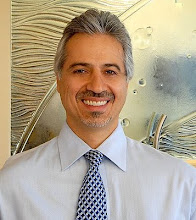Pinhole Gum Rejuvenation
Dr. Fallah and his entire office make every effort to offer the most comfortable and personalized attention possible to each patient visiting the lovely and relaxing dental offices in the Carlsbad (northern coastal San Diego) area. They endeavor to make sure patients are happy with their experiences and are treated with the latest, state-of-the art dental techniques.
One of Dr. Fallah's latest advanced dental services is a brilliant new gum rejuvenation technique that is offered by only a few dentists in the world.
 |
| Conventional vs Pinhole Gum Rejuvenation |
As seen on the TV show "The Doctors" - this receding gum treatment is fast, safe and nearly completely pain-free. It can be done so quickly that you literally can be treated during your lunch hour.
Benefits of Pinhole Gum Rejuvenation
PAIN RELIEFThis latest gum rejuvenation technique is so non-invasive and so gentle that it is almost entirely painless. Patients are amazed at how comfortable this gum treatment actually is -- and how they do not have to have stitches!
SHORTENED TREATMENT TIME
Dr. Fallah treats 4-6 teeth per hour with the Pinhole Gum technique as opposed to the 1-2 teeth an hour speed of the traditional gum grafting. Because so much gum area can be treated in a single day - multiple trips to the dentist are not required for repeated gum graftings.
EFFECTIVITY
The state-of-the-art Pinhole Gum Rejuvenation treatment has been proved to effective (see study results below) and can provide results you hope for almost immediately that last long-term.
LESS INVASIVE
The incision size is literally the size of a pinhole - and DOES NOT required stitches.
FAST HEALING
Traditional gum surgery required 3 weeks for healing. Pinhole Gum Rejuvenation only needs 1 day.
If you are concerned about gum recession, need a solution, but are worried about the time, pain and inconvenience of gum surgery, contact Dr. Fallah's office today and arrange for your quick and easy "Lunchtime Gumlift."
Call today to meet your friendly and caring San Diego Holistic Dentist - Dr. Fallah - 760-730-1600
and relax in our comfortable, state-of-the-art surroundings...
Dr. John Chao researched, refined and developed the new gum recession treatment technique. A 33-month study of 43 patients with 121 gum recessions using the Pinhole Surgical Technique™ was published in the October 2012 issue of The International Journal of Periodontics and Restorative Dentistry. The results of this study indicated that the technique was as successful as traditional gum grafting procedures requiring surgery, cutting and sutures. It also reported that patients who underwent the Pinhole Surgical Technique™ indicated there was virtually no pain, no bleeding and that they were highly satisfied with the rapid transformation of the defective gum line. (Int J Periodontics Restorative Dent 2012; 32: 521-531.)
PRF and Dentistry
PRF
stands for platelet rich fibrin.
The use of PRF in dentistry was first introduced by its
inventor Dr. Joseph Choukroun MD from France.
Healing
factors as related to the patient:
1) When a patient has low vitamin D levels; below 30 ng per ml of blood, healing
will be slowed, and it is also associated with higher levels of allergies. The
human body produces its own antibiotics, vitamin D is necessary for this
process. (Reference: Olsen, European Journal of clinical microbiology)
Deficiency
of vitamin D increases the prevalence of the harmful strains of the following
bacteria in the body: Staphylococcus, Streptococcus, Klebsielia, E. coli, and
Candida.
57% of
patients going through surgery of any kind have a deficiency in vitamin D. Deficiency
in vitamin D also increases the prevalence of neuromuscular pain by 50%. Supplementation
with vitamin D should be with D2 & D3 for one month before surgery for
patients who are deficient in vitamin D.
Furthermore,
there is a correlation between higher levels of vitamin D and lower LDL and
" bad cholesterols".
2) High
levels of LDL are proportional with high levels of oxidized LDL, which is
responsible for the death of the osteoblast cells. (Reference M. Brudeur 2009
cholesterol metabolism and osteoblasts)
3) Higher
viscosity of blood is proportional to Hematocrit levels over 45%, which
creates sluggish blood flow and slows down the healing.
4) High
blood pressure and Atherosclerosis also reduce the blood flow.
5)
Smokers typically have high LDL, high hematocrit levels, high blood pressure,
and Atherosclerosis.
If you have any questions, please contact your San Diego Holistic Dentist, Dr. Fallah for more information.
If you have any questions, please contact your San Diego Holistic Dentist, Dr. Fallah for more information.
Toxic Mercury and Changes
WHY is Mercury Still Used?
At Least One Dental School is Forward-Looking
Research has
also indicated that the most toxic metal is mercury --
considered to be more toxic that lead, arsenic or cadmium.
With all of the negative indicators
piling up, nearly fifty percent of all U.
S. dentists still use mercury fillings in their practices and a large number of
U. S. dental schools continue to teach with mercury fillings as the material of
choice.
In contrast, graduates of the New York
University (NYU) College of Dentistry will not be taught with mercury amalgam
materials. A faculty letter recently
sent to students at NYU cited the United Nations Environmental Program which
proposes that mercury-containing products, including amalgam, be phased out of
use. The faculty letter also cited the
large mercury load in the waterways of the world, including those of America. A major source of that mercury is dental
offices.
NYU, reported these and other issues
that caused it to take the course of teaching students alternative ways to care
to patient teeth, stating that, "all treatment plans should consider
alternative restorative materials other than amalgam."
NYU is not going completely
mercury-free, will still include amalgam
preparation design and placement, however, they have officially revised the
default restoration material from amalgam to composite. The letter also states
that:
·
Amalgam may
still be used, however, approval for placement must be received from faculty
after student-proposed justification.
·
Dental students
will be trained in use of amalgam, but will be instructed in indications and contraindications.
·
Strict mercury
hygiene procedures are to be followed when using amalgam in both the clinic and
preclinical settings.
For more information on the effects of mercury -- watch the video below ...
Then call your holistic dentist - Dr. Fallah -- 760-730-1600 - TODAY!
The Headache and TMJ
Tension headaches are the most commonly occurring type of headache. These may be due to depression, anxiety, stress or holding the neck and head in abnormal positions. This causes the headache as the muscles tighten in the neck, shoulders, scalp and jaw. Tension headaches most often occur on both sides of the head, generally starting at the back of the head and spreading forward. Pain associated with tension headaches can be squeezing or dull, like a tightening vice or band – that’s why we often feel the urge to rub the painful area – a natural move to loosen the muscles.
Temporomandibular joint disorder (TMJ) headaches may feel similar to the tension headache, as the mucles of the head, neck and jaw contract.
Additional symptoms, however, may be associated with TMJ problems such as:
• Jaw popping, clicking or grating sounds when opening and closing the mouth
• Pains and dull aching of the face and facial muscles
• Discomfort or difficulty when chewing or biting.
• Biting or chewing difficulty or discomfort
• Earache
• Painful jaw – or jaw tenderness
• Reduction in jaw range – or inability to widely open or easily close the mouth.
Whatever the symptoms and causes of your own TMJ and headaches, Dr. Fallah is specially trained in dealing with TMJ and all of its ramifications. He uses state-of-the art procedures and equipment to measure and analyze your unique situation. Call today and find immediate relief.
760-730-1600
Temporomandibular joint disorder (TMJ) headaches may feel similar to the tension headache, as the mucles of the head, neck and jaw contract.
Additional symptoms, however, may be associated with TMJ problems such as:
• Jaw popping, clicking or grating sounds when opening and closing the mouth
• Pains and dull aching of the face and facial muscles
• Discomfort or difficulty when chewing or biting.
• Biting or chewing difficulty or discomfort
• Earache
• Painful jaw – or jaw tenderness
• Reduction in jaw range – or inability to widely open or easily close the mouth.
Whatever the symptoms and causes of your own TMJ and headaches, Dr. Fallah is specially trained in dealing with TMJ and all of its ramifications. He uses state-of-the art procedures and equipment to measure and analyze your unique situation. Call today and find immediate relief.
- San Diego headache
760-730-1600
Mercury Free Dentist -- Alzheimer's Information
Apolipoprotein E (APOE), a class of apolipoprotein found in the chylomicron and IDLs, binds to a specific receptor on liver cells and peripheral cells.
APOE was initially recognized for its important role in cardiovascular disease and lipoprotein metabolism. Recently APOE has been studied for its the part it plays in a number of biological processes not directly related to lipoprotein transport, including Alzheimer's disease (AD), immunoregulation, and cognition.
APO-E4 was identified in 1997 as a significant risk factor for early onset of Alzheimer's. APO-E2 was identified as protective against Alzheimer's.
APO-E has 299 amino acids with different ratios of arginine and cysteine at position 112 and 158.
APO-E2 has 2 cysteines. APO-E3 one cysteine and one arginine. APO-E4 two arginines.
Arginine, unlike cysteine, lacks the sulphydryl (SH) groups that potentially bind bivalent metals such as mercury, lead, copper or zinc.
Logically, the possibility of increased metal accumulation could be suspected in chronically exposed individuals
who did not gnentically inherit APO-E2.
In 2003, Godfrey found a statistically significant increase in adverse effects to patients having APO-E4/4 and APO-E 3/4 when those patients were chronically exposed mercury.
Boyd E. Haley, PhD surmises that mercury released from dental amalgams could be a potential cause of
autism and Alzheimer's disease. See his video below for more information:
Be sure to call Dr. Fallah -- your
760-730-1600
APOE was initially recognized for its important role in cardiovascular disease and lipoprotein metabolism. Recently APOE has been studied for its the part it plays in a number of biological processes not directly related to lipoprotein transport, including Alzheimer's disease (AD), immunoregulation, and cognition.
APO-E4 was identified in 1997 as a significant risk factor for early onset of Alzheimer's. APO-E2 was identified as protective against Alzheimer's.
APO-E has 299 amino acids with different ratios of arginine and cysteine at position 112 and 158.
APO-E2 has 2 cysteines. APO-E3 one cysteine and one arginine. APO-E4 two arginines.
Arginine, unlike cysteine, lacks the sulphydryl (SH) groups that potentially bind bivalent metals such as mercury, lead, copper or zinc.
Logically, the possibility of increased metal accumulation could be suspected in chronically exposed individuals
who did not gnentically inherit APO-E2.
In 2003, Godfrey found a statistically significant increase in adverse effects to patients having APO-E4/4 and APO-E 3/4 when those patients were chronically exposed mercury.
Boyd E. Haley, PhD surmises that mercury released from dental amalgams could be a potential cause of
autism and Alzheimer's disease. See his video below for more information:
Be sure to call Dr. Fallah -- your
- San Diego Mercury Free Dentist
Maternal Blood Mercury Concentration and Infant Weight
Birth weight is a strong determinant of attained weight at early ages. Until now, many studies have reported that low birth weight corresponds with high mercury levels. However, the relationship between mercury exposure and attained weight of infant has not been well studied.
Therefore, the aim of a recent study was to assess the degree of prenatal exposure to mercury by measuring the total mercury levels in maternal and cord blood, and examine the relationship between the mercury level during pregnancy and the attained weight of infant during the first 24 months of life.
The prospective cohort study of Mothers and Children's Environmental Health (MOCEH) was built up in 2006, and 921 mother–infant pairs were recruited. Information on the socio-demographic characteristics, health behavior and environmental exposure were collected from an interview with trained nurses.
After delivery, infants and mothers were followed up at 6, 12 and 24 months and the weights of the infants were measured.
The mercury concentrations in the late maternal blood (β=−0.19. p=0.05) and cord blood (β=−0.36. p=0.01) were negatively associated with the infants' attained weight over the first 24 months of age.
The infants' attained weight in the small for their gestational age (SGA) group was lower than the normal birth weight group at the highest quartile of the mercury level.
Therefore, efforts should be made to reduce the mercury level in the maternal blood at late pregnancy and cord blood.
Further research on the possible harmful effects of prenatal mercury exposure on postnatal growth is recommended.
See pdf report on Mercury and Infant weight >>>
Therefore, the aim of a recent study was to assess the degree of prenatal exposure to mercury by measuring the total mercury levels in maternal and cord blood, and examine the relationship between the mercury level during pregnancy and the attained weight of infant during the first 24 months of life.
The prospective cohort study of Mothers and Children's Environmental Health (MOCEH) was built up in 2006, and 921 mother–infant pairs were recruited. Information on the socio-demographic characteristics, health behavior and environmental exposure were collected from an interview with trained nurses.
After delivery, infants and mothers were followed up at 6, 12 and 24 months and the weights of the infants were measured.
The mercury concentrations in the late maternal blood (β=−0.19. p=0.05) and cord blood (β=−0.36. p=0.01) were negatively associated with the infants' attained weight over the first 24 months of age.
The infants' attained weight in the small for their gestational age (SGA) group was lower than the normal birth weight group at the highest quartile of the mercury level.
Therefore, efforts should be made to reduce the mercury level in the maternal blood at late pregnancy and cord blood.
Further research on the possible harmful effects of prenatal mercury exposure on postnatal growth is recommended.
See pdf report on Mercury and Infant weight >>>
Subscribe to:
Posts (Atom)








